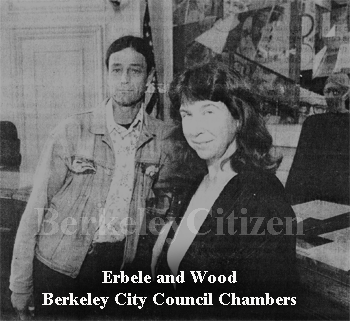Video Commentary
Berkeley City Council
Berkeley City Council
Video Commentary Comes before Council
Will Harper, Berkeley Voice, April 13, 1995Anyone who has been to a City Council meeting in recent years has probably seen L A Wood. Wood, is a southwest Berkeley neighborhood activist with an uncanny knack for having his request-card selected to speak during the council's public comment period.
Week after week he talks for the allotted three minutes about the things affecting his neighborhood: the noise and pollution from the city's corporation yard, the lease to the Berkeley Lawn Bowling Club, and the importance of street sweeping in maintaining a healthy environment.
Now Wood has another weapon in his activist arsenal: video. With a high-resolution home-video camera Wood has produced three mini-documentaries with his friend Carolyn Erbele: the first on storm water runoff, the second on the dangers posed by UC Berkeley's proposed toxic waste site in Strawberry Canyon, and the latest a thoughtful 12-minute look at the traffic problems in his south Berkeley neighborhood caused by the dozens of official trucks and cars going in and out of the city's corporation yard each day.
His most recent work, "Traffic in Transit," cost $300 to make and took three months to produce. Wood turns the "kill your television" view favored by some activists on its head. Instead of criticizing television as an opiate breeding passivity, Wood sounds a McLuhan-like optimism that television, combined with affordable video tools, invites public participation rather than discourages it.
In fact, he says, video offers a more persuasive medium to present one's viewpoint than, say, speaking for three minutes at the council's open-mike. When Wood was stalled for weeks by the city manager from showing his production on the corporation yard -- the manager said the city first wanted to develop a policy on video presentations -- to the council he decided to take another approach.
At a February council meeting Wood brought several of his friends along to fill out request-cards to speak during public comment. After the cards were selected. Wood, using his own video equipment, showed his piece on the corporation yard -- the first time anyone could recall video being used during public comment at a council meeting.
After the presentation and several runs on Berkeley's cable public access channel, Wood said there are changes being made at the corporation yard. For example, 40 city gardeners who used to leave the yard each morning and then drive back for lunch before returning to their off-site work, don't return for lunch now.
Wood added that the council also held off approving an $85,000 expenditure to fix a fuel line at the yard, to study alternative fueling schemes.
"They always say a picture's worth a thousand words, and undoubtedly the pictures made an impression on us," said Councilwoman Diane Woolley-Bauer.
For weeks Wood has pressed for an official policy on video presentations at City Council meetings. "If the council really wants public participation they're going to have to accept video," Wood said.
Wood also welcomes the addition of televised council meetings. Since October council meetings have been televised on Channel 25, the city's public access channel. "I think they (the council) fear that with a video record they can't have it the way they used to have it. They may end up with more participation than they ever wanted."
Tuesday the council adopted a video presentation policy that limits videos to ten minutes, requires advance scheduling and approval of the city manager and the council, and prohibits private businesses from showing promotional tapes.
Assistant City Manager Phil Kamlarz said the need for a policy became apparent last year after one graphic video presentation on the use of bovine growth hormone (BGH) on dairy cows upset many people, and another by a local courier company amounted to a commercial.
Kamlarz added that the policy would help ensure meetings to proceed in a timely manner.
Amy Resner, the chief of staff for Mayor Shirley Dean, said the policy was a reflection of the times. "The fact we're in this video age means there are going to be more people wanting to make video presentations."
Councilwoman Polly Armstrong said the new policy would give council members time to prepare to watch presentations with a discerning-eye.
"I think video technology is so new it's easy for us to be enamored with it. We're not accustomed to asking the same questions to someone showing a video as we are with someone speaking to us. Soil's easy (with video) to get one side of the issue and not notice the other side is missing," Armstrong said.
"If we didn't have some pretty tough rules," she added, "we'd end up with everyone in town with a special interest and a video camera wanting to show us a video."
Wood said the "new" policy isn't really new at all. It is essentially the same procedure that was in place last year before the BGH-video made some council members nervous about video presentations, he said.
In the intervening months, Wood said, he was forced to wait for the "new" policy to be crafted.
Kamlarz said that no official policy was ever adopted before. Kamlarz said the policy would go into effect once the city can install equipment to allow a direct feed of video presentations into the cable broadcast for home-viewers. Kamlarz estimated it would take four to six weeks and anywhere from $1,500 to $5,000 to make a direct feed possible.
Berkeley Citizen © 2003
All Rights Reserved
All Rights Reserved

